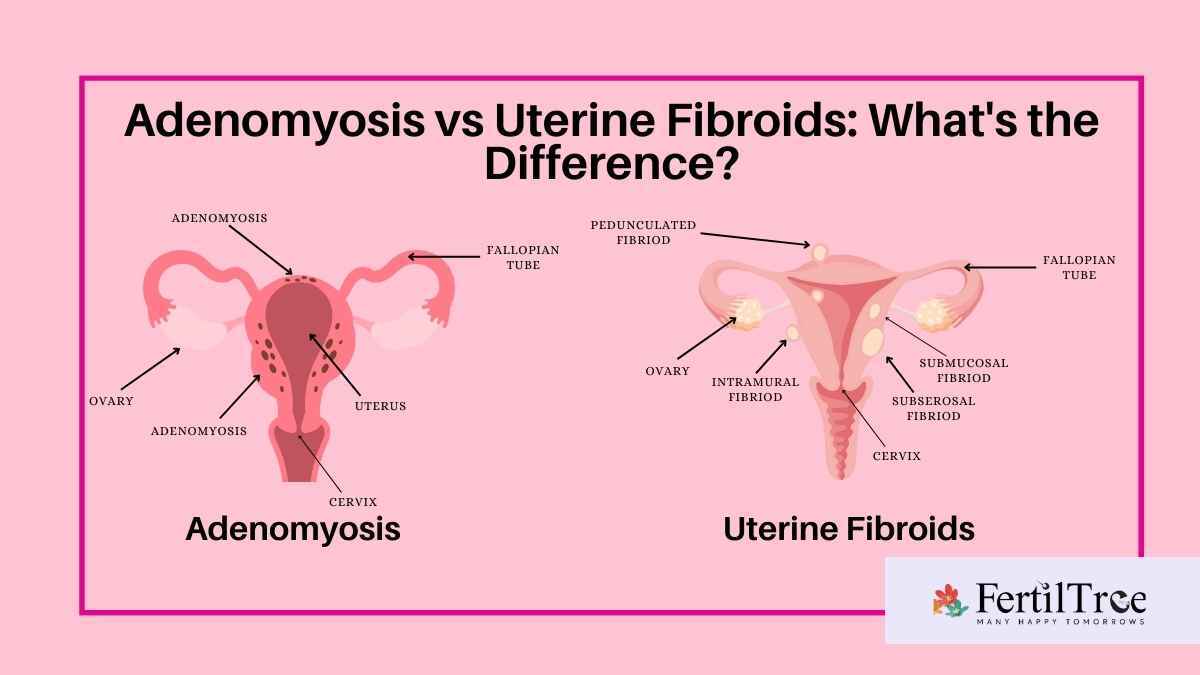
Adenomyosis is the presence of endometrial glands within the musculature of the uterus. Adenomyotic areas are not enclosed by a fibrous capsule. Adenomyosis may be diffuse or may be localised. Adenomyosis is frequently found together with other uterine issues like endometriosis. Read on to know more about Adenomyosis vs. Uterine Fibroids.
Table of Content
Adenomyosis vs. Uterine Fibroids: Are they similar in any case?
How to Tell the Difference Between Adenomyosis and Fibroids?
How Are Adenomyosis and Uterine Fibroids Diagnosed?
What Is the Treatment for Adenomyosis and Uterine Fibroids?
What Is the Prognosis for Adenomyosis and Uterine Fibroids?
Uterine fibroids are usually circular growths of the uterine musculature. They are benign and rarely turn malignant. Fibroids can be tiny or can grow significantly and can be the size of the pregnant uterus at term. Fibroids are classified as subserous, intramural, submucous, cervical, parasitic, or may even be located in the broad ligament.
While most women who have fibroids don’t show any signs of symptoms or discomfort, those who do often find these growths difficult to manage. Symptoms may include pain & heavy menstrual periods. Reports show that adenomyosis is most likely to affect women within the age range of 40-50 years. Depending on your condition, treatment options vary accordingly.
Adenomyosis vs. Uterine Fibroids: Are they similar in any case?
They have some similarities in that they both originate in the musculature of the uterus. The factors that aggravate them can be genetic or hormonal. Both these conditions can cause infertility and miscarriage.
How to Tell the Difference Between Adenomyosis and Fibroids?
Most of the time, it can be easy to differentiate between fibroids and adenomyosis. An ultrasound examination shows a cycle spokes appearance in the case of adenomyosis. The junctional zone is the junction of the endometrium, and the myometrium is more than 12 mm in case of adenomyosis. The ultrasound shows heterogeneous areas of thickening in the case of adenomyosis.
Fibroids appear distinct with a covering that is seen clearly. Their location may also give their diagnosis. They may also appear in clusters.
Adenomyosis and fibroids are both typically painless; however, fibroids are by far more common among females aged 35-54.
Fibroids can affect women of any age, and don’t discriminate when it comes to age brackets. How many and what size fibroids you may have depends on your individual situation. There may be growth or no growth in size, and the rate of increase could vary as well.
Adenomyosis vs. Uterine Fibroids: What Are the Symptoms?
Sometimes adenomyosis and fibroids may not cause any symptoms. As the adenomyosis and the fibroids grow, they can cause pressure on the bladder, frequent and heavy bleeding, infertility and pain which is more frequently associated with adenomyosis.
Common symptoms of fibroids:
Fibroids are non-cancerous tumours that can grow in and around the uterus. They are a common issue among women of reproductive age, and while they are usually harmless, they do come with some uncomfortable symptoms.
Common symptoms of fibroids include , pelvic pain, heavy menstrual bleeding and pressure, frequent urination and bloating. In some cases, fibroids can even cause infertility. Knowing the symptoms of fibroids is important for early detection and treatment to minimise the discomfort caused by this condition.
- Periods can be uncomfortable, with heavy or inconsistent flow cycles.
- Cramps, pain and pressure in the pelvic region can be debilitating.
- Back as well as leg pain
- Abdominal bloating or swelling is a common issue in the lower abdomen area.
- Gaining weight
- Pain during coitus
- Frequency of urination
- Constipation, diarrhoea, and rectum pain
- Feeling weak and fatigued.
Common adenomyosis symptoms:
Adenomyosis is a condition that affects the uterus, and it can cause a variety of symptoms. Common symptoms of adenomyosis include heavy or prolonged periods, cramping, and pain during intercourse. Other less common symptoms include bloating, lower back pain, constipation, and fatigue.
It’s important to note that these symptoms are not always indicative of adenomyosis; however, if you experience any of them regularly, it’s important to speak to your doctor or healthcare provider for further evaluation.
- Menstrual bleeding that is abnormally long and/or heavy
- Experiencing intense cramping or sharp pains that feel like a knife stabbing in the pelvis during the menstrual cycle
- Menstrual cramps that persist for an extended period of time than normal
- Pain in the leg(s)
- Enlarged uterus
- Pain during coitus
- Bloating
- Bleeding in between cycles
- Experiencing blood clots during a menstrual period
- Pressure on the lower abdominal area.
How Are Adenomyosis and Uterine Fibroids Diagnosed?
These can be diagnosed by palpation, ultrasound, MRI and by some blood tests.
What Is the Treatment for Adenomyosis and Uterine Fibroids?
The treatment depends on the symptoms and whether the condition is associated with infertility. The treatment can be surgical or medical.
The fibroids can be removed laparoscopically. In cases of localised adenomyosis, these can be excised. In severe cases of adenomyosis and fibroids, a hysterectomy may have to be performed. Sometimes hormonal treatment with birth control pills, only progesterone pills, or subcutaneous injections of GnRH depot may help. Recent treatment is with oral antagonists.
What Is the Prognosis for Adenomyosis and Uterine Fibroids?
The prognosis depends on the size, position and duration of both the conditions. Removal of fibroids is easier and can reverse infertility. If the adenomyosis is significant, it can cause infertility or repeated miscarriages.
Read more: Follicular Study: Purpose, Procedure, and Success Rate
Read more: Thin Endometrium Lining | Symptoms, Causes & Treatments
Read more: IVF Step By Step Process

